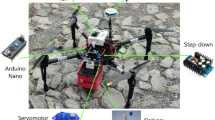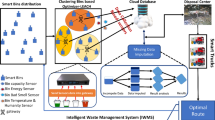Abstract
In this paper we present a map-assisted pedestrian navigation system for smartphone user which combines map information, IMU-based Pedestrian Dead Reckoning (PDR) and Wi-Fi localization using fingerprinting method. PDR (Pedestrian Dead Reckoning) using smartphone consist with step detection, step length estimation and heading estimation. However, these algorithms have errors caused by various reasons such as step length error at uncertain user, magnetic disturbance in indoor situation and unstable position of smartphone. To increase accuracy of the PDR, Wi-Fi fusion or map matching method has been proposed. However, previous methods could not solve fault matching or creating map in hall area. Especially in hall, pedestrian could make various trajectories that accurate map structures are required. For solving the structure of map database in hall problem and accurate link selection, we propose a Virtual Link (VL) algorithm with a Virtual Track (VT). Furthermore, an Extended Kalman Filter (EKF) is used for estimating pedestrian position and IMU sensor errors. With map information, step length estimation error, heading error at pedestrian dead reckoning and some IMU sensor errors are estimated. Real world experiments are conducted at building, and it shows less than 3m of CEP (Circular Error Probability) after 200m walk.
Similar content being viewed by others
References
G. J. Kim, T. K. An, J. P. Kim, Y. G. Cheong, and M. H. Kim, “Directional pedestrian counting with a hybrid mapbased model,” International Journal of Control, Automation and Systems, vol. 13, no. 1, pp 201–211, February 2015.
S. Park and S. K. Park, “Global localization for mobile robots using reference scan matching,” International Journal of Control, Automation and Systems, vol. 12, no. 1, pp. 156–168, February 2014.
R. Jirawimut, P. Ptasinski, V. Garaj, F. Cecelja, and W. Balachandran, “A Method for dead reckoning parameter correction in pedestrian navigation system,” IEEE Trans. on Instrumentation and Measurement, vol. 52, no. 1, pp. 209–215, April 2003.
R. W. Levi and T. Judd, “Dead reckoning navigational system using accelerometer to measure foot impacts,” United States Patent No. 5, 583, 776, 1996.
Q. Ladetto, “On foot navigation: continuous step calibration using both complementary recursive prediction and adaptive Kalman filtering,” Proc. of the 13th International Technical Meeting of the Satellite Division of The Institute of Navigation (ION GPS 2000), pp. 1735–1740, September 2000.
S. H. Shin, C. G. Park, H. S. Hong, and J. M. Lee, “MEMSbased personal navigator equipped on the user’s body,” Proc. of the 18th International Technical Meeting of the Satellite Division of The Institute of Navigation (ION GPS 2005), pp. 1998–2002, September 2005.
J. Kappi, J. Syrjarinne, and J. Saarinen, “MEMS-IMU based pedestrian navigator for handheld devices,” Proc. of the 14th International Technical Meeting of the Satellite Division of The Institute of Navigation (ION GPS 2001), pp. 1369–1373, September 2001.
K. Sagawa, M. Susumago, and H. Inooka, “Unrestricted measurement method of three-dimensional walking distance utilizing body acceleration and terrestrial magnetism,” Proc. of the International Conference on Control, Automation and Systems (ICCAS 2001), pp. 707–710, October 2001.
S. Y. Cho, C. G. Park, and G. I. Jee, “Measurement system of walking distance using low-cost accelerometers,” Proc. of the 4th ASCC, September 2002. [click]
V. Gabaglio, “Centralised Kalman filter for augmented GPS pedestrian navigation,” Proc. of the 14th International Technical Meeting of the Satellite Division of The Institute of Navigation (ION GPS 2001), pp. 312–318, September 2001.
K. Aminian, P. Robert, E. Jequier, and Y. Schutz, “Level, downhill and uphill walking identification using neural networks,” Electronics Letters, vol. 29, no. 17, pp. 1563–1565, August 1993. [click]
S. Y. Cho, “Design of a pedestrian navigation system and the error compensation using RHKF filter,” Ph.D Dissertation, Kwangwoon Univ., Korea, February 2004.
S. Y. Cho and C. G. Park, “A calibration technique for a two-axis magnetic compass in telematics devices,” ETRI Journal, vol. 27, no. 2, pp. 280–288, June 2005.
M. J. Caruso and L. S. Withanawasam, “Vehicle detection and compass applications using AMR magnetic sensors,” Sensors, Expo Proc., vol. 477, pp. 39, May 1999. [click]
C. E. White, D. Bernstein, and A. L. Kornhauser, “Some map matching algorithms for personal navigation assistants,” Transportation Research: Part C: Emerging Technologies, vol. 8, no. 1, pp. 91–108, December 2000.
M. A. Quddus, W. Y. Ochieng, L. Zhao, and R. B. Noland, “A general map matching algorithm for transport telematics applications,” GPS Solutions, vol. 7, no. 3, pp. 157–167, September 2003.
W. Y. Ochieng, M. A. Quddus, and R. B. Noland, “Integrated positioning algorithms for transport telematics applications,” Proc. of the 17th International Technical Meeting of the Satellite Division of The Institute of Navigation (ION GNSS 2004), pp. 692–705, September 2004.
S. Kim and J. H. Kim, “Adaptive fuzzy-network-based Cmeasure map-matching algorithm for car navigation system,” IEEE Trans. on Industrial Electronics, vol. 48, no. 2, pp. 432–441, April 2001.
M. A. Quddus, W. Y. Ochieng, and R. B. Noland, “A high accuracy fuzzy logic based map matching algorithm for road transport,” Journal of Intelligent Transportation Systems, vol. 10, no. 3, pp. 103–115, January 2007. [click]
X. Zhang, Q. Wang, and D. Wan, “Map matching in road crossings of urban canyons based on road traverses and linear heading-change model,” IEEE Trans. on Instrument and Measurement, vol. 56, no. 6, pp. 2795–2803, December 2007. [click]
S. H. Shin, H. W. Kim, C. G. Park, and S. O. Choi, “Map-matching algorithm for MEMS-based pedestrian dead reckoning system in the mobile device,” Journal of Institute of Control, Robotics and Systems, vol. 14, no. 11, pp. 1189–1195, November 2008.
S. H. Shin, C. G. Park, and S. O. Choi, “New mapmatching algorithm using virtual track for pedestrian dead reckoning,” ETRI Journal, vol. 32, no. 6, pp. 891–900, December 2010.
R. Toledo-Moreo, D. Bétaille, F. Peyret, and J. Laneurit, “Fusing GNSS, dead-reckoning, and enhanced maps for road vehicle lane-level navigation,” IEEE Journal of Selected Topics in Signal Processing, vol. 3, no. 5, pp. 798–809, October 2009.
S. Beauregard and M. Klepal, “Indoor PDR performance enhancement using minimal map information and particle filters,” Proc. of IEEE/ION Position, Location and Navigation Symposium (PLANS), pp. 141–147, May 2008. [click]
N. Tradisauskas, J. Juhl, H. Lahrmann, and C. S. Jensen, “Map matching for intelligent speed adaptation,” IET Intelligent Transportation Systems, vol. 3, no. 1, pp. 57–66, March 2009. [click]
M. Ren and H. A. Karimi, “A hidden markov model-based map-matching algorithm for wheelchair navigation,” Journal of Navigation, vol. 62, no. 3, pp. 383–395, July 2009. [click]
M. Yu, Z. Li, Y. Chen, and W. Chen, “Improving integrity and reliability of map matching techniques,” Journal of Global Positioning Systems, vol. 5, no. 1-2, pp. 40–46, December 2006.
M. A. Quddus, W. Y. Ochieng, and R. B. Noland, “Integrity of map-matching algorithms,” Transportation Research Part C, vol. 14, no. 4, pp. 283–302, August 2006.
T. M. Rafael, B. David, and P. Francois, “Lane-level integrity provision for navigation map matching with GNSS, dead reckoning, and enhanced maps,” IEEE Trans. on Intelligent Transportation Systems, vol. 11, no. 1, pp. 1–13, October 2009.
M. G. Puyol, D. Bobkov, P. Robertson, and T. Jost, “Pedestrian simultaneous localization and mapping in multistory buildings using inertial sensor,” IEEE Trans. on Intelligent Transportation Systems, vol. 15, no. 4, pp. 1714–1726, August 2014.
P. Bahl and V. N. Padmanabhan, “RADAR: an in-building RF-based user location and tracking system,” Proc. of 19th Annual Joint Conference of the IEEE Computer and Communications Societies (INFOCOM 2000), vol. 2, pp. 775–784, March 2000. [click]
Y. Chen and H. Kobayashi, “Signal strength based indoor geolocation,” Proc. of the IEEE International Conference on Communications (ICC 2002), vol. 1, pp. 436–439, May 2002. [click]
Author information
Authors and Affiliations
Corresponding author
Additional information
Recommended by Associate Editor Bin Jiang under the direction of Editor Fuchun Sun. This journal was supported by the ICT R&D program of MSIP/IITP. [R0101-15-0168, Development of ODM-interactive Software Technology supporting Live-Virtual Soldier Exercises].
Min Su Lee received his B.S. and Ph.D. in the School of Mechanical and Aerospace Engineering of Seoul National University in 2008. His current research interests include the pedestrian dead reckoning, indoor navigation, context awareness and kinematic based position using multiple wearable sensors.
Hojin Ju is a Ph.D. student in the School of Mechanical and Aerospace Engineering of Seoul National University, Seoul, South Korea. He received his B.S. in Mechanical Engineering from Korea Aerospace University in 2012. His current research interests include the pedestrian dead reckoning, inertial navigation systems, nonlinear filter and pattern recognition.
Chan Gook Park received the B.S., M.S., and Ph.D. in control and instrumentation engineering from Seoul National University, Seoul, Korea, in 1985, 1987, and 1993, respectively. He worked with Prof. Jason L. Speyer on peak seeking control for formation flight at the University of California, Los Angeles (UCLA) as a postdoctoral fellow in 1998. From 1994 to 2003, he was with Kwangwoon University, Seoul, Korea, as an associate professor. In 2003, he joined the faculty of the School of Mechanical and Aerospace Engineering at Seoul National University, Korea, where he is currently a professor. From 2009 to 2010, he was a visiting scholar with the Department of Aerospace Engineering at Georgia Institute of Technology, Atlanta, GA. He served as a chair of IEEE AES Korea Chapter until 2009. His current research topics include advanced filtering techniques, inertial navigation system (INS), GPS/INS integration, MEMS-based pedestrian dead reckoning, and FDIR techniques for satellite systems.
Rights and permissions
About this article
Cite this article
Lee, M.S., Ju, H. & Park, C.G. Map assisted PDR/Wi-Fi fusion for indoor positioning using smartphone. Int. J. Control Autom. Syst. 15, 627–639 (2017). https://doi.org/10.1007/s12555-015-0342-2
Received:
Revised:
Accepted:
Published:
Issue Date:
DOI: https://doi.org/10.1007/s12555-015-0342-2




